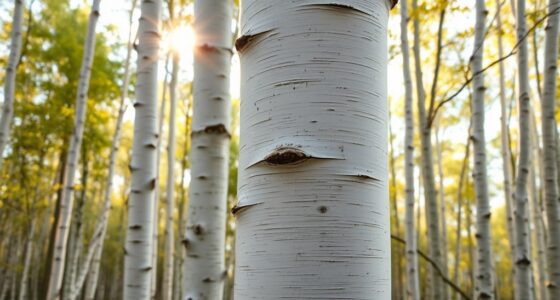Elm leaf beetles mainly target elm trees, chewing holes and skeletonizing leaves, while Japanese beetles feed on a variety of plants like roses and grapes, creating ragged holes and a lace-like appearance. Both cause leaf damage, but elm beetles focus on one tree type, and Japanese beetles affect many plants. To learn how to identify and control these pests effectively, keep exploring for helpful tips.
Key Takeaways
- Elm leaf beetles primarily target elm trees, causing larvae to strip leaves completely, while Japanese beetles feed on a wider range of plants.
- Both pests skeletonize leaves, creating a lace-like appearance, but elm leaf beetles tend to create irregular holes and defoliation.
- Elm leaf beetle larvae can cause severe defoliation, weakening trees, whereas Japanese beetles mainly cause damage to ornamental and fruit plants.
- Adult elm leaf beetles chew on leaf surfaces, while Japanese beetles feed between veins, leading to similar skeletonization effects.
- Natural predators and ecosystem balance are key for control; chemical treatments should be used selectively for severe infestations.

When it comes to pest problems in your garden, understanding the differences between the elm leaf beetle and the Japanese beetle is essential. Both pests feed on leaves, but they do so in distinct ways that can considerably impact your trees and plants. Recognizing their feeding habits helps you choose the most effective management strategies, whether that’s encouraging natural predators or applying chemical treatments.
The elm leaf beetle primarily targets elm trees, with larvae and adults feeding on the leaves. Adults chew on the leaf surface, creating irregular holes and skeletonizing the foliage, which weakens the tree over time. The larvae, however, are voracious feeders, stripping leaves entirely and leaving behind only the veins. This intense feeding can cause severe defoliation, leaving the tree vulnerable to stress and disease. In contrast, Japanese beetles are less selective, attacking a wide variety of plants, including roses, grapes, and fruit trees, along with elms. They skeletonize leaves by feeding between the veins, resulting in a lace-like appearance that can quickly defoliate plants if left unchecked.
Managing these pests requires different approaches. Natural predators play an indispensable role, especially for the elm leaf beetle. Birds, lady beetles, and parasitic wasps naturally prey on eggs and larvae, helping keep populations in check without chemical intervention. Promoting a balanced ecosystem in your garden by avoiding broad-spectrum insecticides allows these natural predators to thrive and control pest numbers effectively. For severe infestations, chemical treatments might be necessary. In such cases, insecticides labeled for elm leaf beetles or Japanese beetles can provide rapid relief. Be sure to follow label instructions carefully to minimize harm to beneficial insects and the environment.
Natural predators like birds and lady beetles are key to controlling elm leaf beetle populations naturally.
While chemical treatments can be effective, they should be used judiciously, ideally as a last resort after other methods have failed. Timing is critical; applying insecticides when beetles are active or larvae are vulnerable maximizes their effectiveness. Additionally, targeting specific life stages reduces the overall chemical load on your garden. On the other hand, fostering natural predators offers a sustainable, eco-friendly way to manage beetle populations over time. Encouraging diversity in your garden, planting resistant varieties, and maintaining healthy, vigorous trees can naturally deter heavy feeding and reduce the need for chemical control.
Frequently Asked Questions
How Can I Prevent Elm Leaf Beetle Infestations?
To prevent elm leaf beetle infestations, you should adopt cultural practices like regular pruning, removing fallen leaves, and keeping your trees healthy. These steps make your trees less attractive to beetles. Also, consider biological controls such as introducing natural predators or applying beneficial nematodes. Combining these methods helps reduce beetle populations naturally and keeps your elm trees healthy and pest-free throughout the season.
Are Japanese Beetles Attracted to Specific Plants?
Did you know Japanese beetles are particularly attracted to over 300 plant species? They’re drawn by plant attraction and tend to prefer certain pests’ preferences, like roses, grapes, and linden trees. If you want to protect your garden, be aware that Japanese beetles target these plants most. Regular inspection and using barriers or natural predators can help manage their pest preferences and keep your plants healthy.
What Natural Predators Control These Beetles?
You can manage these beetles naturally by encouraging their predators. Birds, such as starlings and sparrows, feed on adult beetles, while parasitic wasps and nematodes target the larvae. Using biological control methods, like releasing beneficial insects, helps maintain balance without chemicals. Integrate natural predator management into your pest control approach to effectively reduce beetle populations and protect your plants sustainably.
Can These Beetles Spread Plant Diseases?
Yes, these beetles can spread plant diseases through their feeding activity. As they feed on leaves, they create wounds that serve as entry points for pathogens, which can compromise plant health. Disease transmission by beetles can weaken your plants, making them more vulnerable to other pests and environmental stress. Monitoring and controlling these beetles promptly helps protect your plants from potential disease spread and maintains overall plant health.
What Effective Organic Treatments Are Available?
You can effectively control beetles with organic sprays like neem oil or insecticidal soap, which target pests without harming beneficial insects. Additionally, try companion planting with herbs like basil or marigolds to repel beetles naturally. Regularly inspect your plants and hand-pick beetles when possible. Combining organic sprays with companion planting creates a robust, eco-friendly defense, keeping your garden healthy and beetle-free.
Conclusion
While both the elm leaf beetle and Japanese beetle are notorious leaf feeders, the Japanese beetle causes more widespread damage, with a single beetle consuming up to 50 square centimeters of leaves daily. Notably, Japanese beetle populations can reach several hundred per tree during peak season, quickly defoliating entire branches. Knowing these differences helps you identify and protect your trees effectively. Stay vigilant, and you’ll better manage these pests before they cause significant harm.









